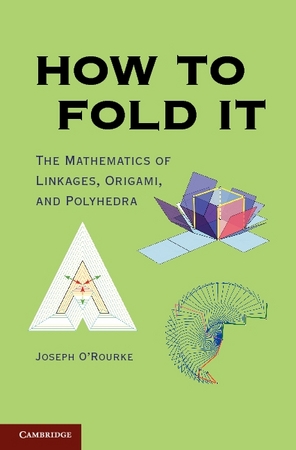

Cambridge University Press link: Cambridge. Amazon link: Amazon.
Now translated into Japanese by Ryuhei Uehara: http://www.jaist.ac.jp/~uehara/books/howtofoldit/ : 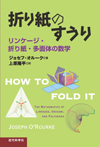
Errata (Updated 9 May 2012)
![]() Last Update to this page:
Last Update to this page:
The book includes descriptions of ten open problems (see the Index under open problem, p. 176). Inevitably, some will be resolved as time passes and before a Second Edition is prepared. Here I will maintain a list of those Open Problems in the book which have been closed, or on which some notable advance has been achieved.
The special case of convex polyhedra has been solved (Yes, they can all be continuously flattened!) Abel, Z., E. D. Demaine, M. L. Demaine, J.-i. Itoh, A. Lubiw, C. Nara, and J. O’Rourke (2014). Continuously flattening polyhedra using straight skeletons. In Proc. 30th Annual Symposium on Computational Geometry (SoCG), pp. 396–405. Association for Computing Machinery. Link to download PDF.
Yes! Zachary Abel. "On folding and unfolding with linkages and origami." Ph.D. Thesis, Massachusetts Institute of Technology, Department of Mathematics, 2016. MIT link.
From Abstract: "we prove a strong form of Kempe's Universality Theorem for linkages that avoid crossings."
See also the longer list of Closed/Open Problems associated with the more advanced monograph, Geometric Folding Algorithms: Linkages, Origami, Polyhedra.
Below appears some supplementary material, organized by chapter. Click on links to jump to that chapter's material:
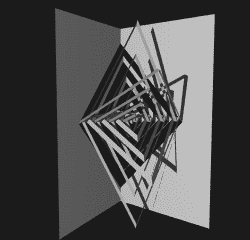 |
|
| Animation by Akira Nishihara. (Click on image to see animated GIF): Nishihara web page. | |
|---|---|
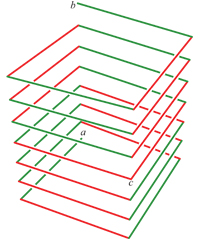 |
|
| Fig. 3.14 (p.51) | Uncurling of a unit 90°-chain as it stretches to its maxspan configuration. [Video by Julia Patterson] |
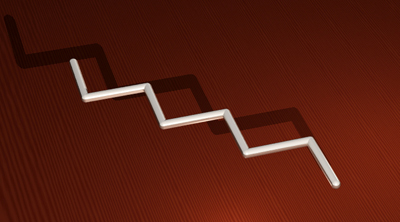 |
|
| Final frame of animation | |
The video is a first attempt at animating the uncurling of the spiral unit 90°-chain. The jittering near the end of the stretch is under investigation...
Click on thumbnail images to bring up 8½ x 11" PDF ready for printing.
| Where | Description | Templates (Color) | Templates (B&W) |
|---|---|---|---|
| Fig. 4.4 | Degree-6 vertex | ||
| Fig. 4.7 | Degree-6 non-flat | ||
| Fig. 4.8 | Maekawa-Justin Theorem | ||
| Fig. 4.14 | Map puzzle |
Click on thumbnail images to bring up 8½ x 11" PDF ready for printing.
| Where | Description | Templates (color) | Templates (B&W) | ||
|---|---|---|---|---|---|
| Fig. 5.2 | Square | ||||
| Fig. 5.3 | Star | ||||
| Fig. 5.5 | Rectangle | ||||
| Fig. 5.7 | Irregular Triangle | ||||
| Fig. 5.9 | Square & Rectangle | ||||
| Fig. 5.11 | Letter 'A' [This corrects one incorrectly labeled crease in Fig.5.11(c).] |
||||
| Letter 'A' with hole | |||||
| Fig. 5.12 | Turtle | ||||
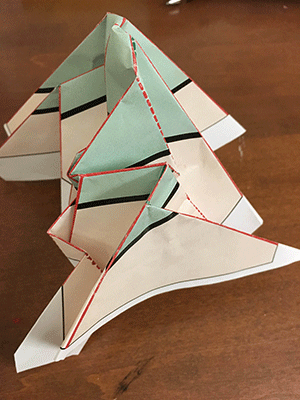
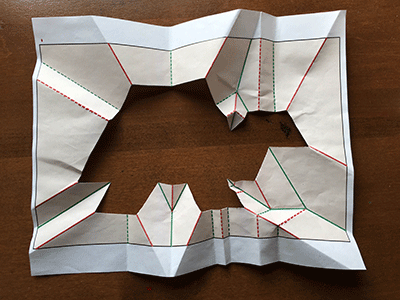
Here is a dynamic version of Figure 7.11: The Latin cross unfolding of the cube.
| Cube to Latin cross. [Video by Katie Park] |
|---|
Here is an edge-unfolding of a cube to a 'Z'-shape, and then a refolding of the 'Z' to double-covered parallelogram. (This example is not in the book, but related.) All the Platonic solids but the dodecahedron have similar edge-unfoldings and refoldings to a parallelogram. Template below in Chapter 9 section.
| Unfolding cube to 'Z'. | Folding 'Z' to parallelogram. |
|---|---|
| [Videos by Katie Park] | |
These four videos show animations of the orthogonal terrain algorithm described in Section 8.1, especially Figures 8.2 and 8.4. For more detail, see my note, "Unfolding Orthogonal Terrains."
| 10 x 10 Terrain, Example 1 | 10 x 10 Terrain, Example 2 |
|---|---|
| 10 x 10 Top only (dynamically rescaled) | 20 x 20 Terrain |
The video below illustrates the basic construction that underlies the algorithm described in Section 8.4 Above & Beyond, especially Figure 8.8. For more detail, see the paper, "Epsilon Unfolding of Orthogonal Polyhedra."
| Helical unwrapping one box to a staircase shape. [Video by Robin Flatland and Ray Navarette] |
|---|
| Where | Description | Templates |
|---|---|---|
(Not in book) |
Which folds to cube? |
|
(Not in book) |
Cube Z → Octahedron |
|
| Fig. 9.6 | Square perimeter-halving. | |
(Not in book. |
Cube Z to Parallelogram | |
| Fig. 9.9 | Latin cross to Tetrahedron | |
| Fig. 9.10 | 'SoCG' polygon: Folds to what? |